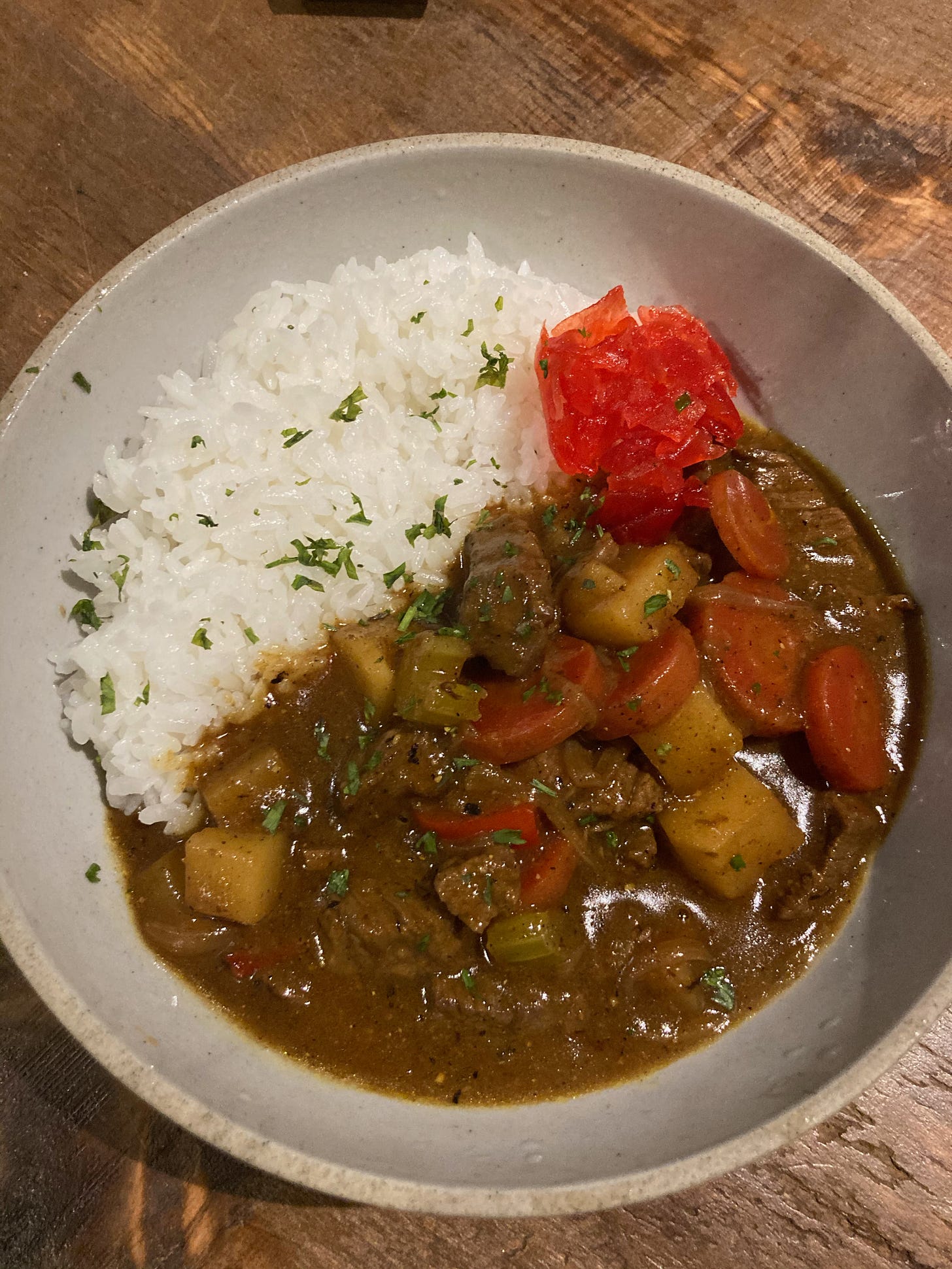Curry rice, and food as ongoing cultural exchange.
Adapted from: karē raisu, Japan's unofficial national dish.
Off the top of your head, how would you define the word “curry”? Is it a dish? Is it a texture? Is it a spice, or a collection of spices? Is it a flavour? Or is it, as it was for me, all of the above—a muddy conflation of every type of curry you’ve ever had?
I first looked up “curry” a few weeks ago, after writing about Alison Roman’s. It’s one of many words I have used all of my life without questioning my grasp on the actual concept. In my experiential understanding of the word, curry is a saucy dish of Indian origin, but the term has been broadened to include dishes of similar textures from other parts of the world, like Southeast Asia, or the Caribbean.
The truth is, as truth often turns out to be, more complicated. According to a Quartz India article:
When the Portuguese arrived as the first Europeans to “discover” India, they came in through the southern ports, and presumably encountered the delicately spiced dishes of Tamil Nadu. In Tamil, the word kari means a kind of gravy. The Portuguese began to apply that phonetically to many Indian dishes. Later, the British Anglicized the term into “curry” when they colonized the subcontinent.
In other words, there is nothing that pins “curry” to a time or place or origin story. Authenticity doesn’t exist, because the term itself is foreign—coined by colonial forces passing through.
These same forces are responsible for how curry spread. It was first introduced to the Japanese by the British in the 1800s, during a period called the Meiji era that marked the nation’s dramatic transition from an isolationist feudal society to an industrialized nation. This period also happened to be the height of Queen Victoria’s colonial reign in India, which led to “a booming industry in pre-made, all-purpose curry powder” for British traders and travelers wanting to replicate the taste of Indian dishes. This generic “curry powder” is what the Brits brought to Japan, purportedly spreading to the rest of the country through its use in the naval force. As a result, modern Japanese curry has more in common with Anglo-Indian cuisine than anything else.
Unsurprisingly, it didn’t stop there. South Koreans were introduced to this version of curry during the Japanese Occupation, and it is now a staple in Korean homes. The Brits also introduced curry powder to the Germans, which later inspired the beloved street food, currywurst. As for Caribbean curries? Same deal. Introduced by indentured laborers from India that the British Empire sent to work on its sugar plantations.
Now, when I think of curry, I think of colonialism.
Making karē raisu
Karē raisu (the Japanese transliteration of curry rice) consists of vegetables (onion, carrots, potatoes, etc.) and chunks of meat simmered in broth, with the addition of a curry roux (flour, fat and spices) to thicken it into a gravy-like sauce. In Japan, instant curry roux is widely available in brick or powder form, which helps expedite the whole thing. Because I love hardship, I decided to make the whole thing from scratch.
I got the curry spice mix from food writer Sonoko Sakai, via Diaspora Co. It starts with toasting the spices:
Then, you grind them into your personal stash of Japanese curry powder. (I am very happy to have some at my disposal, for when the craving strikes next.)
Combine the powder with flour and butter to make a roux brick.
Use the roux in your simmering pot of vegetables and meat, watch the whole thing get thick and glossy before your eyes, then serve on white rice with fukujinzuke (a type of Japanese pickles) to your stomach’s great delight.
Recipe notes:
Sonoko Sakai’s Japanese Chicken Curry
Since I was using her spice mix, I thought I’d follow her recipe, too. I replaced the chicken broth and meat with beef and beef broth because that’s what I had on hand, but next time would probably stick with chicken as I found the beef flavour overpowering. Otherwise, the recipe is simple and great as followed. To make things simple, buy an instant curry brick, like Vermont Curry.
What is your favourite form of curry? Send me a recipe if you’re so inclined. My window of eating cold foods has come to a close for the season, so it’s curries and soups from here on out.
Until next time,
Tracy 🍛






